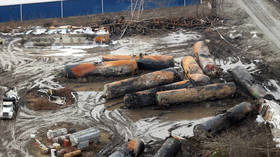Ohio chemical disaster may hold long-term health risks – experts

The pollutants in the air of East Palestine, Ohio, may pose long-term health risks, scientists from Texas A&M and Carnegie Mellon University claimed on Wednesday. Their assessment contrasts the US Environmental Protection Agency’s (EPA) assurance that the pollution does not pose an immediate health risk.
Dr. Albert Presto, an associate research professor at Carnegie Mellon University, told CNN on Wednesday that the situation in East Palestine was not an “immediate health concern” but that it could still pose long-term risks as the researchers had no way of telling how long the hazardous chemical concentration would persist. He added that the residents of the city were in “constant contact” with the pollutants and there was no clear understanding of what that level of exposure would mean for the population’s health.
The air in the Ohio city was contaminated in early February, after 38 cars of a Norfolk Southern freight train derailed and spilled out the hazardous materials they were carrying. The accident caused a fire that went on for multiple days and intensified the airborne spread of the chemical pollution, causing a mandatory evacuation of the nearby residents. The EPA has been conducting various tests and measurements in the affected area, claiming there was no immediate risk to the local population.
Texas A&M and Carnegie Mellon presented their independent assessment in a Twitter post last week. The scientists claim to have used data compiled by the EPA and found that nine of the 50 chemicals found in East Palestine’s air were above the norm for the region. In particular, the report singles out acrolein, a toxic substance used to control plants, algae, rodents and microorganisms.
The EPA responded to the claims in the report from the two universities by dismissing the perceived risks. A spokesperson for the agency told CNN on Monday that the report assumed “a lifetime of exposure, which is constant exposure over approximately 70 years” for the harmful effects to manifest. They added: “EPA does not anticipate levels of these chemicals will stay high for anywhere near that.”
Dr. Ivan Rusyn, the director of the Texas A&M University Superfund Research Center and part of the team that did the analysis, told CNN on Wednesday that “all sides were right” as both parties simply needed to keep monitoring the situation and “do a better job communicating the results.”













